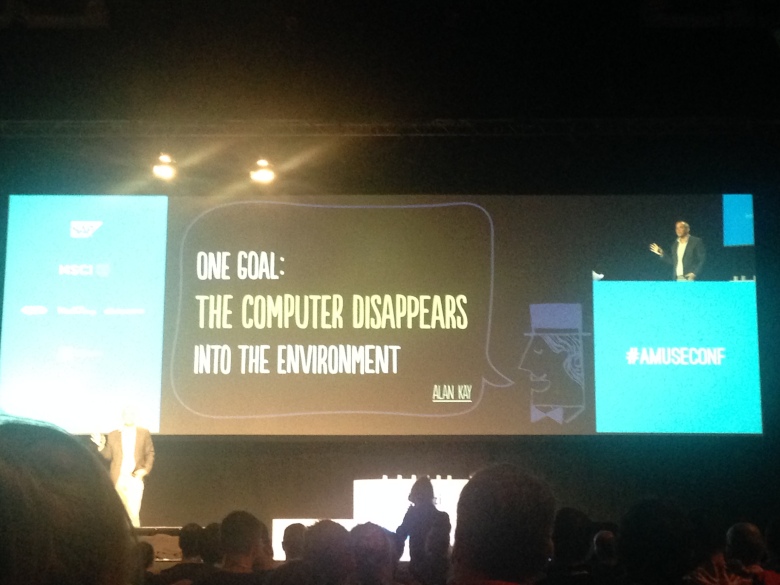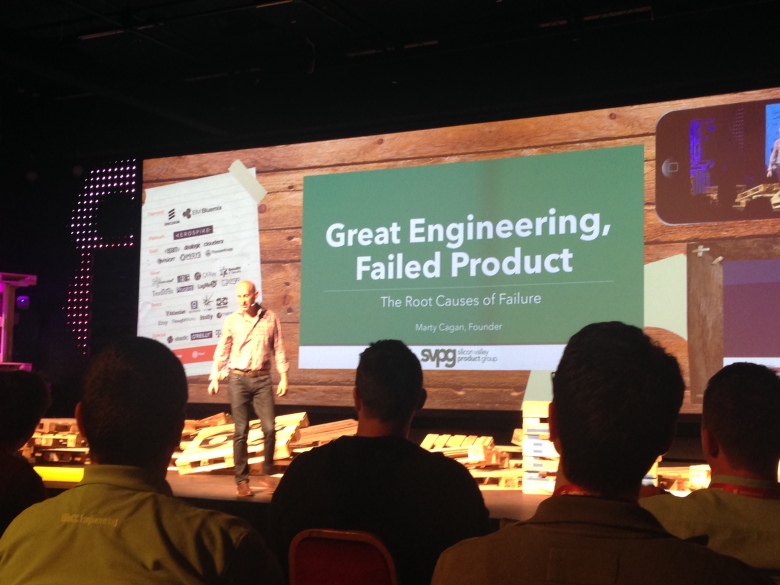Last week, I had the privilege of being part of a group attending the first edition of AmuseConf on behalf of our company. Amuse is “an international conference for anyone interested in how to design and develop successful products that users love”. It’s organized by the same good folks that bring us the outstanding CraftConf year after year, sponsored primarily by Prezi and UStream (and SAP in case of Amuse). They did a near-perfect job, with only minor glitches with the seating and catering on the first day. Considering that the Big Data oriented CrunchConf was also literally next door, the event was practically flawless. Fast, uninterrupted WiFi and no food options for vegetarians/vegans remained a hallmark this organizing team (even though Tom Illmensee, event MC is himself vegetarian 😉 ).
(BTW, if you’re wondering why so many tech conferences are being hosted in Budapest, the event’s WiFi password should give you a hint):

510 attendees from 32 countries (as far away as Australia) made Amuse a roaring success, as did its impressive lineup of Speakers. 27% of the speakers were women, which is great for a tech conference — I hope next year we have even more!
Below is a summary of the talks I found the most relevant to my work. But by no means does that mean you should skip the other talks… depending on where you are and what you’re doing, you might be interested in some of the eclectic topics covered such as:
- Designing web interfaces for children by Trine Falbe
- Conducting research outside “sample of convenience” by Bill Selman from Mozilla Foundation
- Design Thinking by Tobias Haug of SAP (my favorite quote: “Innovation = Execution x Creativity”)
- How to get your dream UX job by Andrew Doherty of Google (worth checking out just for his mad presentation skills)
- The Ethical Designer by Cennydd Bowles
- Storytelling in a multidevice landscape by Anna Dahlstrom
Design Equilibrium
Jonathan opened the conference with a very engaging talk drawing parallels between businesses and ecosystems: a “balanced exchange of value between Actors, Enterprise and Brand”. He gave practical examples citing the application of Lynn Shostack’s work on Service Blueprinting to a transformation in the healthcare industry. I strongly encourage viewing his inspiring talk on YouTube.
His core suggestion is a separation of Product Design from Service Design. The latter “fills in whitespaces between points of [rich] engagement provided by products”, helping to restore balance to the overall experience, and hence the business ecosystem. This is the real intangible value of services, as opposed to products.
He also proposed the concept of an “Engagement Model”: a framework to contextualize all the data a business collects.
UX: Design as a Science
By Joel Marsh, author of the UX Crash Course
Joel’s key message was that “Scientific UX Design is reproducible”: essentially drawing on the principles of the Lean Startup and applying them to the UX domain. His presentation was one of the most popular and engaging ones, and his quotes and examples garnered a lot tons of positive feedback. One thing that struck me was his exposition on the two types of creativity: Creative expression and creative problem solving. He noted that an over-applicability of creative expression can make you feel good as a designer, but result in an over-designed and bloated product:
Another talk I would highly recommend watching when it comes out on UStream.tv.
Making Dog Food a Part of Your Balanced Diet
Toby used his work at Simple Bank to highlight the pros and cons of “eating your own dogfood”. The initial employees used the app themselves, and one of the downsides was that the missed revelation that users of such a smooth app had to deal with a paper form-based process to close their account, which took up to 20 days.
Another inspiring talk that you should definitely check out, full of quotes of wisdom like:
- “Delight is design’s superpower”
- A past discussion on Leadership strategy: “Build a shared vision, get the **** out of the way”
- “UX is not about throwing technology at a problem, but throwing people at a problem”
On the other hand, Simple A/B tested as many as 16 variations of their login page (for more examples, check out UserOnboard.com).

Live posters being created by @remarker_eu
How We Built Hotjar and Onboarded 50k Users in a Year
David used practical examples from Hotjar to support his model of “Drivers, Barriers and Hooks” when dealing with site visitors. He also put a quirky twist on some timeless wisdom:
The two most amazing insights for me were:
- Hotjar captures every single customer interaction on a Trello board, and uses that feedback to prioritize their features.
- They also make their roadmap public, which demonstrates their commitment and at the same time reduces enquiries about feature requests
- They use the income from their paid customers to fund the creative freedom to build features for their free customers
The Invisible Interface: Designing the Screenless Experience
Avi, founder of UXSalon, opened with a discourse on recent editions of Microsoft Productivity Future Vision. From there he led the discussion on towards a future without bigger and wider screens (which wouldn’t require “superhuman arm strength”):
- “The most profound technologies are the ones that become invisible”
- Like automatically opening sliding doors
- “Voice UI is the future”
- “Gesture control is here to stay, but not on screens”
The Best Interface is No Interface
Golden surmised that we are all “chipping away at digital chores”, and we don’t have to be “slaves to screens”. He has laid the foundations of the #NoUI movement with his book: “The Best Interface is No Interface”. His excellent talk (slides here) was supported by book reading and real examples. Also, don’t forget to check out his accompanying toolkit on “how to create elegant solutions with no screens”.
For further inspiration to join the movement, take a look at his Producthunt collection of “interfaces that require little or no time with screens”.
Magical UX and the Internet of Things
By Josh Clark
Josh opened with an announcement of his book release: “Designing for Touch”. His presentation was literally magical, complete with a wand, to the point that he managed to tie in together excerpts from preceding talks and put the whole conference in perspective. I found a similar slidedeck from one of his previous talks here, and I highly recommend taking a look at it while we wait for the official conference videos to come up on Ustream.tv. It was a treasure trove of out-of-the box examples like:
- Augmented REality Sandtable (ARES), which literally turns dirt into a high-tech, military-grade user interface… using not much more than a Kinect and projector
- Grab Magic, which brings superpowers to data transfer
- Propeller Health, which connects Asthma inhalers to phones for health monitoring
Josh’s key message was “interaction at the point of inspiration”: that we should think of “the whole world is an interface, just like it has always been”. He proposed “thereables” instead of wearables: bits of smart technology in the physical space where we would expect to interact with them, not something we burden ourselves by carrying or wearing all day long. To this end, he suggested that “the smartphone is Magic Wand 1.0 for everyone” and we should start thinking of it as just more than a screen.

Regarding user interfaces, he had 3 bits of advice that I found remarkable:
- “Technology should amplify our humanity”
- “We shouldn’t educate users on how technology works, unless we really *have* to”
- “Honor intention, don’t assume it”
Josh ended with a call to action:
Like this one.





